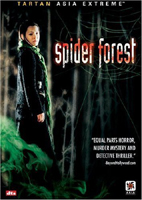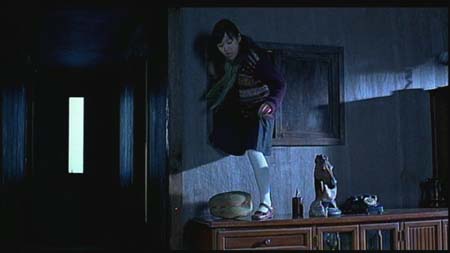 BUY IT AT AMAZON: CLICK HERE!
BUY IT AT AMAZON: CLICK HERE!
STUDIO: Tartan Video
MSRP: $24.99
RATED: R
RUNNING TIME: 120 Minutes
SPECIAL FEATURES:
• Deleted Scenes
• Behind the Scenes
• Cast Interviews
• Trailers
Hope no
one who steps into Spider Forest likes their genres individually packaged,
because this Korean murder mystery is a collision of crime, the supernatural
and melancholy romance with a total disregard for linear storytelling.
The Flick
A man
wakes up in the forest. He wanders to a desolate house set amongst the trees.
Inside, he finds carnage — a man and woman dead, stabbed like voodoo dolls in
a Haitian day school. Worse, both are known to him. Hearing a noise, he chases
a shadow out into the woods, and is clubbed into unconsciousness. Waking once
more, he stumbles along a road into a tunnel, where yet another dimly glimpsed
form leads to an unpleasant vehicular fate.
Unconsciousness
to waking and back again. Spider Forest works like that. It’s
built on a loop that circles back around over the course of the film, and many
of the subplots seem like their own little narrative culs de sac. That’s a
fancy way of saying that the movie really has only a small story to tell, and it
takes its sweet time tipping that fact to you.
.jpg)
To help
consumers pre-visualize their arrangements, the Ikea in Silent Hill splattered
blood on all the showroom furniture.
It’s
obvious from the outset that our guy, Min, has something to do with the murders
in the woods. But he’s got a shoddy memory and we’ve got to meander through
flashbacks to get the truth. (There’s always a mess to wade through when
solving a mystery.) Instead of offering a load of potential suspects as you’d
find in a Lawrence Block novel, the film throws up layered memories which have
to be sorted out. Is Min’s last memory of his late wife important to us, or
only to him?
The
process isn’t entirely unappealing; there’s almost a character to work with in
Min, and his troubled past evokes enough sympathy that I was willing to stick
with him. Gam Woo-sung has an appealing face; he’s equally convincing drunk and
belligerent, wounded, or totally lost.
And there
are flashes of genuine mystery in the film. The story of the Spider Forest,
where forgotten souls are trapped until they can be remembered, is effective
despite the fact that you’ve probably seen another film with a similar story
before. Even the familiar can be frightening if enough shadows, spiders and
unidentified presences are added.
And
because the film trades in elliptical dead-ends, it’s easy to think that
there’s a lot more potential brimming than really awaits. Eventually it will
dawn that Spider Forest is fronting, at least a little. It tries to weave
together a ghost story, metaphysical revenge tale and downbeat love story, and
all three aspects finally feel shortchanged.
.jpg)
This is
the second time I’ve seen the film. The first was at a festival a little over a
year ago, where I enjoyed it as a sort of overblown murder mystery with a heavy
allegiance to Lost Highway. I still appreciate the air of uncertainty that
permeates the story, but I was a lot less patient with it on DVD. I wanted more
focus and more detail, since each of the movie’s three potential pathways
promised something more interesting than what Spider Forest is able to
deliver.
6.2 out of 10
The Look
Fittingly,
Spider
Forest is dark and murky. The colors are richly saturated, but there’s
still a sense of viewing everything through a thin layer of vellum or gauze.
This
transfer doesn’t do the film any favors — it’s grainy and noisy, but I dimly
recall thinking the same thing about the image when I saw the film projected in
2004. What I don’t recall is the absurd amount of edge enhancement that turns
the few daylight forest scenes into automated migraine generators. Some of it could
have been shot on a camera phone.
.jpg)
"Yes. Shitty transfers save lives."
Putting
it lightly, the image clarity won’t impress anyone. At least the presentation
is anamorphic, so people with widescreen sets don’t get doubly screwed by the
grain.
5 out of 10
The Noise
It’s good
to have a DTS track for a film that’s atmospheric instead of loud and clanging.
The DTS adds a little touch of presence even to the quiet passages, and since
there are plenty of those, it’s welcome. The Dolby track is louder and a little
more brash. It’s not bad, but the more subtle DTS works a lot better for the
film.
7.8 out of 10
The Goodies
Based on
the feature list, it seems like there’s a lot here, but in truth all three
major offerings are disposable. The trio of interviews is superficial, and the
behind the scenes piece is exactly that — a bunch of footage taken on set,
assembled with no context or detail about how the film was conceived.

One-legged girls dancing on furniture don’t need captions.
The
deleted scenes are also strung together in one big chunk, and run about twelve
minutes. There’s a reason all were cut; most of the material merely gives extra
glimpses into Min’s life with his girlfriend. At times a scene threatens to
change the nature of their relationship as it appears in the final cut, but
most of the time the footage just explicitly shows things we can already infer
from the existing cut. Since the film is all about mystery, we’re better off
relying on inference.
4 out of 10
The Artwork
It would
be easy to mistake this cover art as representative of many different films.
That’s probably the point. But there are
several striking images in the film that would sell it better than this tame,
be-anything shot.
5.5 out of 10
Overall:
6 out of 10